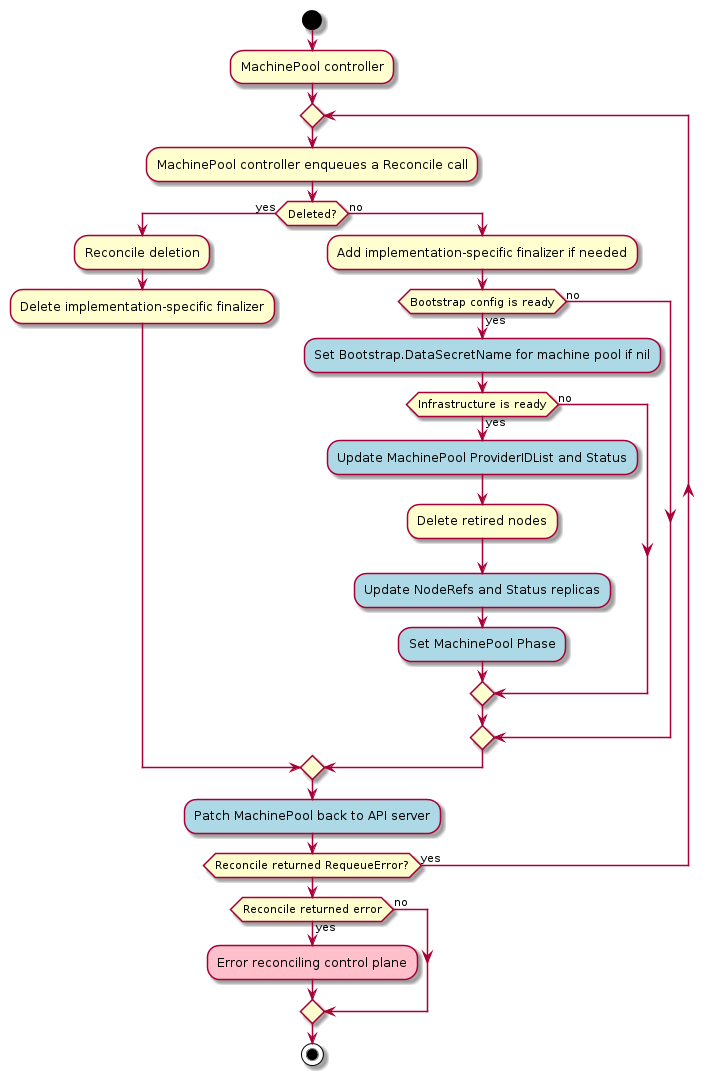MachinePool Controller

The MachinePool controller’s main responsibilities are:
- Setting an OwnerReference on each MachinePool object to:
- The associated Cluster object.
- The associated BootstrapConfig object.
- The associated InfrastructureMachinePool object.
- Copy data from
BootstrapConfig.Status.DataSecretNametoMachinePool.Spec.Template.Spec.Bootstrap.DataSecretNameifMachinePool.Spec.Template.Spec.Bootstrap.DataSecretNameis empty. - Setting NodeRefs on MachinePool instances to be able to associate them with kubernetes nodes.
- Deleting Nodes in the target cluster when the associated MachinePool instance is deleted.
- Keeping the MachinePool’s Status object up to date with the InfrastructureMachinePool’s Status object.
- Finding Kubernetes nodes matching the expected providerIDs in the workload cluster.
After the machine pool controller sets the OwnerReferences on the associated objects, it waits for the bootstrap
and infrastructure objects referenced by the machine to have the Status.Ready field set to true. When
the infrastructure object is ready, the machine pool controller will attempt to read its Spec.ProviderIDList and
copy it into MachinePool.Spec.ProviderIDList.
The machine pool controller uses the kubeconfig for the new workload cluster to watch new nodes coming up.
When a node appears with a Node.Spec.ProviderID in MachinePool.Spec.ProviderIDList, the machine pool controller
increments the number of ready replicas. When all replicas are ready and the infrastructure ref is also
Ready, the machine pool controller marks the machine pool as Running.
Contracts
Cluster API
Cluster associations are made via labels.
Expected labels
| what | label | value | meaning |
|---|---|---|---|
| MachinePool | cluster.x-k8s.io/cluster-name | <cluster-name> | Identify a machine pool as belonging to a cluster with the name <cluster-name> |
Bootstrap provider
The BootstrapConfig object must have a status object.
To override the bootstrap provider, a user (or external system) can directly set the MachinePool.Spec.Bootstrap.DataSecretName
field. This will mark the machine as ready for bootstrapping and no bootstrap data secret name will be copied from the
BootstrapConfig object.
Required status fields
The status object must have several fields defined:
ready- a boolean field indicating the bootstrap config data is generated and ready for use.dataSecretName- a string field referencing the name of the secret that stores the generated bootstrap data.
Optional status fields
The status object may define several fields that do not affect functionality if missing:
failureReason- a string field explaining why a fatal error has occurred, if possible.failureMessage- a string field that holds the message contained by the error.
Example:
kind: MyBootstrapProviderConfig
apiVersion: bootstrap.cluster.x-k8s.io/v1alpha3
status:
ready: true
dataSecretName: "MyBootstrapSecret"
Infrastructure provider
The InfrastructureMachinePool object must have both spec and status objects.
Required spec fields
The spec object must have at least one field defined:
providerIDList- the list of cloud provider IDs identifying the instances.
Required status fields
The status object must have at least one field defined:
ready- a boolean field indicating if the infrastructure is ready to be used or not.
Optional status fields
The status object may define several fields that do not affect functionality if missing:
failureReason- is a string that explains why a fatal error has occurred, if possible.failureMessage- is a string that holds the message contained by the error.
Example:
kind: MyMachinePool
apiVersion: infrastructure.cluster.x-k8s.io/v1alpha3
spec:
providerIDList:
- cloud:////my-cloud-provider-id-0
- cloud:////my-cloud-provider-id-1
status:
ready: true
Secrets
The machine pool controller will use a secret in the following format:
| secret name | field name | content |
|---|---|---|
<cluster-name>-kubeconfig | value | base64 encoded kubeconfig that is authenticated with the workload cluster |